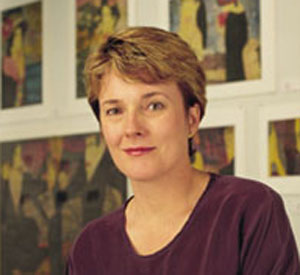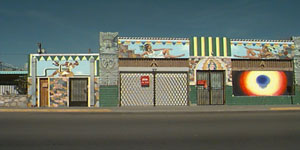The El Paso art scene, never very robust from a commercial gallery standpoint, is taking some hits. For a very long time now, the Hal Marcus Gallery and the Adair Margo Gallery, just down the street from each other, have been considered the two major art galleries in El Paso. In fact, until recently, they were essentially the only galleries here. Hal Marcus Gallery closed on February 9. Adair Margo is moving her gallery, but unsure as to precisely where, and is therefore temporarily reducing her inventory as well as the space available for shows.
The Hal Marcus closing means there is one less venue for artists in a city with already limited outlets. But the closing will probably have little impact on the area’s more contemporary artists. The Hal Marcus Gallery specialized in generally realistic paintings, usually desert and Southwest images, but it always topped every favorites list. And for those drawn to brightly-colored canvases, it was unbeatable.
Many of Hal Marcus’s artists are fairly well established and are also members of the El Paso Art Association, an organization that tends to promote its members and sponsors in large regional shows. It fancies itself an important player in the El Paso art scene. But in fact, with its emphasis on traditional realistic Sunday afternoon painter works and its refusal to encourage any artistic concept produced after, say, 1910, it tends to sit like a boulder on the windpipe of creativity. Both these entities are loved by the general public and often regarded with scorn by a large variety of young artists. Reactions to the Hal Marcus closing ranged from a general expression of sympathy by El Paso Art Museum Director Michael Tomor and Marcus’s fellow gallerist Adair Margo, to relief from my 17-year-old friend Chloe who said, “Oh, thank God, the art sucks.”
While Hal Marcus has disappeared and Adair Margo, who represents such nationally known artists as Luis Jiménez, is scaling down and moving, there has been a corresponding rise in galleries catering to younger, more adventurous artists. Galleries like Space Available Gallery (SPAG), Under the Sun and now Ramblin’ have provided space for a whole new group of artists. But even these younger artists kept looking at Hal Marcus as some sort of model, which is why Keith Spencer of SPAG likened the closing to “the fall of the Berlin Wall.” His point was that people will now have to come up with a different model or create something new in the void.
Everyone contacted for this article emphasized that the closing of Hal Marcus Gallery in no way indicated any lessening of artistic activity in town. This is true, but the problem is, where does this creative activity go? Other than Adair Margo, El Paso has never really developed a traditional gallery system where a gallery owner has an exclusive arrangement to represent certain artists. Hal Marcus had no such arrangement with its artists. None of the new galleries represent artists. SPAG makes its walls available to whoever wants to rent wall space; Under the Sun curates, but owner Jeff Litchfield emphasizes that he does not represent artists in the usual sense. The newest gallery, Ramblin’, seems more like a place for friends to hang out than any sort of major gallery.
The lack of a traditional gallery format means there isn’t the grooming and education of clientele, or artists for that matter, that occurs when you have the more traditional gallery system in place. Kate Bonansinga, director of the Rubin Center, a contemporary art center affiliated with the University of Texas at El Paso, quoted a former gallery owner friend who said, “All sales involve education.” Bonansinga went on to suggest that the two major institutions in town, The Rubin Center and the El Paso Museum of Art, will actually perform some of this education for the benefit of local artists.
This might be true. The El Paso Museum of Art has made several attempts at expanding awareness with bi-national shows. The show “Sister Cities: Testing Boundaries” was held last summer and another juried show is scheduled to open this summer, drawing artists from a 300-mile radius, including both sides of the border. These kinds of projects will hopefully help open people up to some of the amazing art being produced in the region. Director Michael Tomor said he hopes that with these shows and others “we can explore trends and movements in our region as reflections of national and international directions in Post Modernism.”
Whether local artists and the public care is another question. There seems to be a tendency towards provincialism even among artists; they do not seem to want to expand. I discussed this with Rhonda Dore, an innovative artist who shows at both Hal Marcus and at SPAG. Dore theorizes that being surrounded by the desert can make people insular, unable to get out of or look beyond their landscape.
Across the border in Juarez, there is a wealth of art being made, drawing on different traditions and with what seems to be more careful attention to technique. But there are even fewer places to show in Juarez. Although everyone talks about creating cross-border relationships (and the bi-national shows have allowed some museum people to form great relationships), there still seems to be general unawareness or lack of interest for American artists to search out Mexican artists.
Some Juarez artists have found their way to SPAG, and others who attend the University of Texas at El Paso will show here and occasionally in Juarez. Even so, the two cities still seem far apart despite some strong efforts on the part of museum directors in both cities to establish a dialogue and exchange, as well as efforts by Adair Margo to show artists from both sides of the border.
The other problem, as several people mentioned, is that there is not a large base of art buyers here who are willing to invest in art, nor a developed mechanism to attract buyers from elsewhere. There are an increasing number of artists from El Paso who are becoming known to a wider audience. Margarita Cabrera shows nationally with a gallery in New York and Alexander Titovets recently secured a commission to paint the first lady, which will certainly heighten his presence.
In Juarez, there have been artistic exchanges organized with places like Oaxaca as well as Cuba. Many artists travel far afield to try to show their works and make sales. But will this engender a realization that there is a huge creative community in the El Paso/Juarez region, or will well-known artists from the border region simply be regarded as anomalies?
Many young artists and art students from UTEP and New Mexico State University in Las Cruces go on to prestigious art schools for graduate work. But until we can either expand the local base of collectors or encourage more people from out of town to come and take a look, they will find it very difficult to sell their work here. This might be a wonderful place to make art, but it is a very difficult place to make a living from that art. That won’t change until a more vibrant commercial gallery scene develops.
Postscript:
Just this week, things got even bleaker. The Hal Marcus Gallery closing might have boosted the visibility of the Space Available Gallery, and, in fact, Spencer did receive a number of calls from artists. But this week, SPAG announced that it is closing on April 1. The two-year-old gallery operated on the premise that anyone could rent wall space for a two-week show, and over one hundred artists took advantage. In a press release, owners Keith and Elena Spencer said the decision to close was based on “various circumstances.”

David Sokolec is a writer living in El Paso.







2 comments
thnx for the article, it’s good to know the el paso art scene is going down in flames. maybe something cool will rise from the ashes.
The state of art in El Paso has been generally poor as long as I can remember for the past 30 years. There have been some great moments though. The early to mid-later eighties comes to mind. The economic conditions just don’t allow for a large enough, educated enough class with the disposable income to support the arts community consistently. And as you and others have said, the city’s proximity just doesn’t invite it’s citizens to be exposed to a full-fledged arts culture.
I recall how so many wonderful artist were in El Paso teaching or learning in the 80s.
UTEP’s art culture was unbelievable dynamic with people like Mark Perlman, Kurt Kemp, Joe Gregory, Ray Parrish, Rachelle Thiewes teaching there. Wonderful student artists that included Sam Reveles, Susan Davidoff, Tomas Vu Daniel. Helen of Troy’s Shenkman family being very involved in supporting the arts. Luis Jimenez, James Drake and others routinely speaking and exhibiting. Adair Margo opens her space and the Bridge Center opens it’s space. There was a huge art symposium with huge-name artist like Larry Bell on the UTEP campus. And, the El Paso Museum of Art was also forcibly being brought to a new and higher level.
Well, just about all, with a couple of exceptions have moved to bigger markets, but the lesson remains that it’s possible to have a robust fine arts community but it will take time, education and money and in El Paso, it may be sporadic as well. I salute those in El Paso who continue to work for the El Paso Arts community.